The Arctic: An ice trial "flight" in depth. The Mir-1 and the Mir-2 diving tests
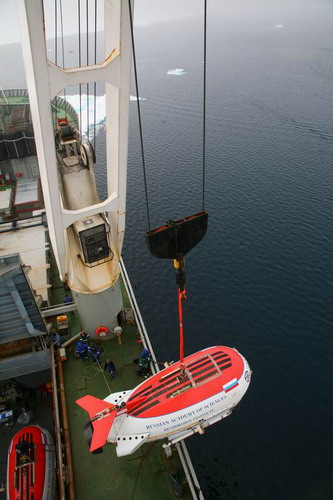 “I love you people!” wrote in the MVK logbook Anatoly Sagalevich, Head of the Laboratory of the deep manned submersibles of Shirshov Institute of Ocean Sciences of the Russian Academy of Sciences.
“I love you people!” wrote in the MVK logbook Anatoly Sagalevich, Head of the Laboratory of the deep manned submersibles of Shirshov Institute of Ocean Sciences of the Russian Academy of Sciences.
Today, on the east side of Franz Josef Land the research vessel Akademik Fedorov has heaved aback. The Mir-1 and Mir-2 deep manned submersibles produced a test dive on the slope of the depth.
Before diving, the Head of the high-Arctic deep-sea expedition, Artur Chilingarov came in a helicopter from the nuclear-powered icebreaker Russia to hold a press conference on the eve of a trial dive. He noted that the test was performed with the descent of the purpose of completing the main task – to ensure full security of the upcoming diving the Mir apparatus to the bottom of the Arctic Ocean at the North Pole target.
“Water samples” were made on the slope of the depth of the shelf zone near Franz Josef Land at 82 degrees of the North latitude and 64 degrees of the East longitude. The employees of ice conditions and forecasts Department of the Arctic and Antarctic Research Institute flew on ice reconnaissance and found an ice-lane, where they decided to dive.
At 9.09 am (Moscow time) the Mir-1 bathyscaphe began breaking the surface and after a few minutes the hatch was battened down, the apparatus was watered bear, and disappeared into the depths. Half an hour later, the Mir-2 dived. Check underwater communications, “I am, the Mir-1, is ready to test the submarine communication” “I am, the Mir-2, in touch” The team included the Mir-1 commander, the pilot Anatoly Sagalevich; the Mir-2 commander, the pilot Evgeny Chernyayev, as well as the flight engineer Igor Ponomarev, and the navigator Sergey Klepikov. The oxygen supply for pilots was for 72 hours, power supply – nearly twice as much. They ate sandwiches, drank tea, and had an “emergency” supply of chocolate.
The sinking speed was 30 meters per minute. An hour after launching the Mir-1, the machine touched the bottom. The depth of 1321 meters. While diving, the Mir-1 manipulator malfunctioned. But the work continued. At 11.51 am (Moscow time) the first device had already been raised from the bottom and was at a depth of one thousand meters. Chilingarov from the bridge, asked for the diving head Victor Poverty, “Do you give the command to raise the second one?” In response, “Once it is finished, I’ll give the command” The Mir-2 at that time was taking samples of fauna and soil.
At 2.40 the Mir-1 came out on an ice-free surface, an hour later the second one appeared.
As the pilots noted after the dive, emersion was difficult. To work in the ice, the system of work with the sonar beacon was changed, as well as the ballasting system, which allows the unit to go down to the depth and rise to the surface.
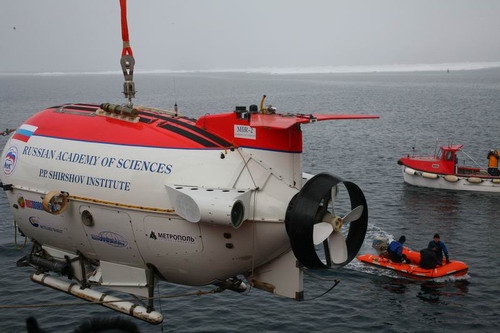
The Mir-1 several times rose to the surface, and then went to a depth again so as not to bang on the ice. Everyone who was on board, veered from one deck to another, looking for the Mir in the water.
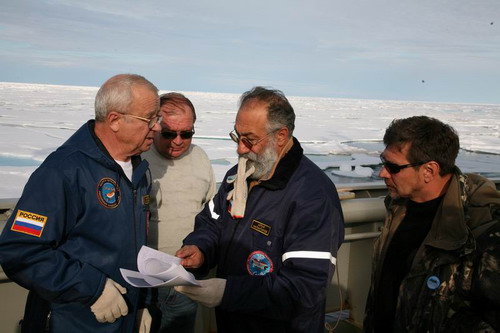
The Special Presidential Representative for the International Polar Year, and the expedition leader Artur Chilingarov at the end of the test dive was happy and satisfied, “All the pilots and staff of the Mir apparatus are professionals and every dive is a real feat of those who go to the depth for the sake of science and all this is done for Russia’s presence in the Arctic Ocean. These people are the first and the only who have celebrated today, Navy Day, at the bottom of the Arctic Ocean”.
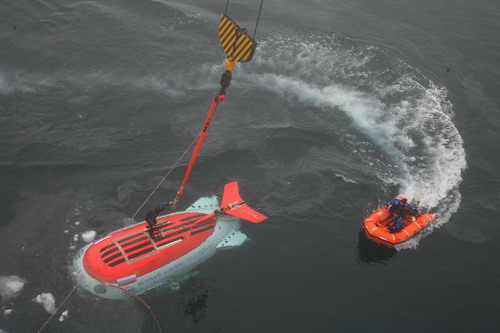
Anatoly Sagalevich said that there were a lot of animals at the bottom, but they were all very small. “We saw a pair of skates, brittle stars, a few fish” Due to some difficulties with the manipulator the Mir-1 did not take soil samples.
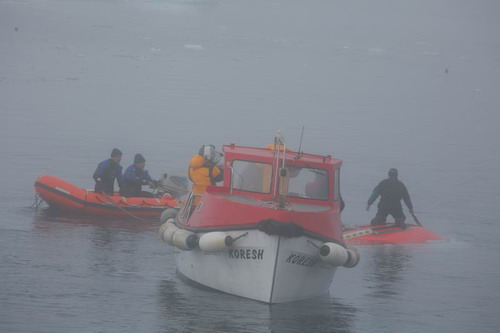
Its partner, wandering a bit under the water, surfaced just at the point where it should have been picked up and moved by the crane into the Fedorov’s lower hold. At that time, a boat and some divers were in the stern of the vessel. Victor Nishcheta told me about the Mir submersibles when suddenly an orange system appeared. I saw the Mir-2 first!
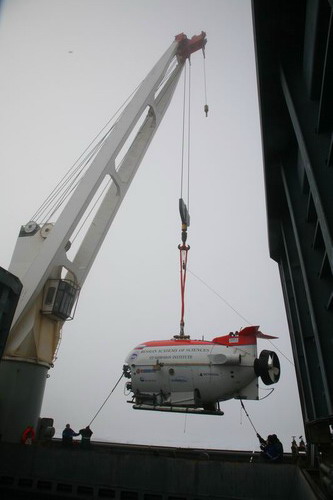
Eugeny Chernyayev left the Mir-2 when the deck was already deserted – boom subsided. He said that at the bottom of the ocean the crew had spent about an hour. The animals were difficult to catch – brittle stars “jumped out”, but stalked lily got to sample. Eugeny has spent about four thousand hours under water. He is an experienced pilot, but surfacing through the ice was not easy even for him. He said that he saw the beacon (transponder) and determined that it was standing off the Fedorov board. “It was difficult to determine where the open water was, and where the ice was. When moving to the surface, saw an ice floe, and dived again. When breaking the surface for the second time, I almost caught on the ice floe with scientific equipment. But the conditions here are much better than at the North Pole”, said Chernyaev. “Compass and gyro work, but at the pole they will not work”.
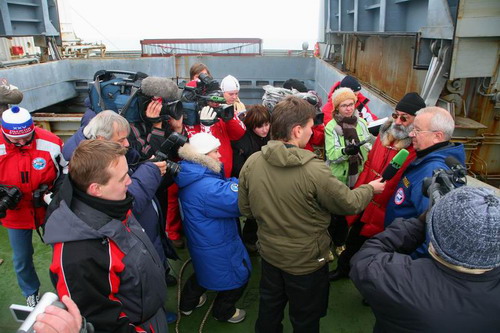
***We recall that on July 10th, the flagship of the Russian polar fleet, the research vessel Akademik Fedorov took off for the Arktika’2007 expedition from St Petersburg. The high-latitude unprecedented deep-water arctic expedition will be organized during the first voyage of the Akademik Fedorov. For the first time in history, Russian deep-water manned submersibles will dive near the North Pole target. The Mir bathyscaphes are to dive 4, 200 m deep under the North Pole.
Natalia Yurchenko
Press Secretary of Director General of MVK
The research vessel Akademik Fedorov, Arktika-2007 expedition
Moscow – Murmansk – Franz Josef Land – the Kara Sea
